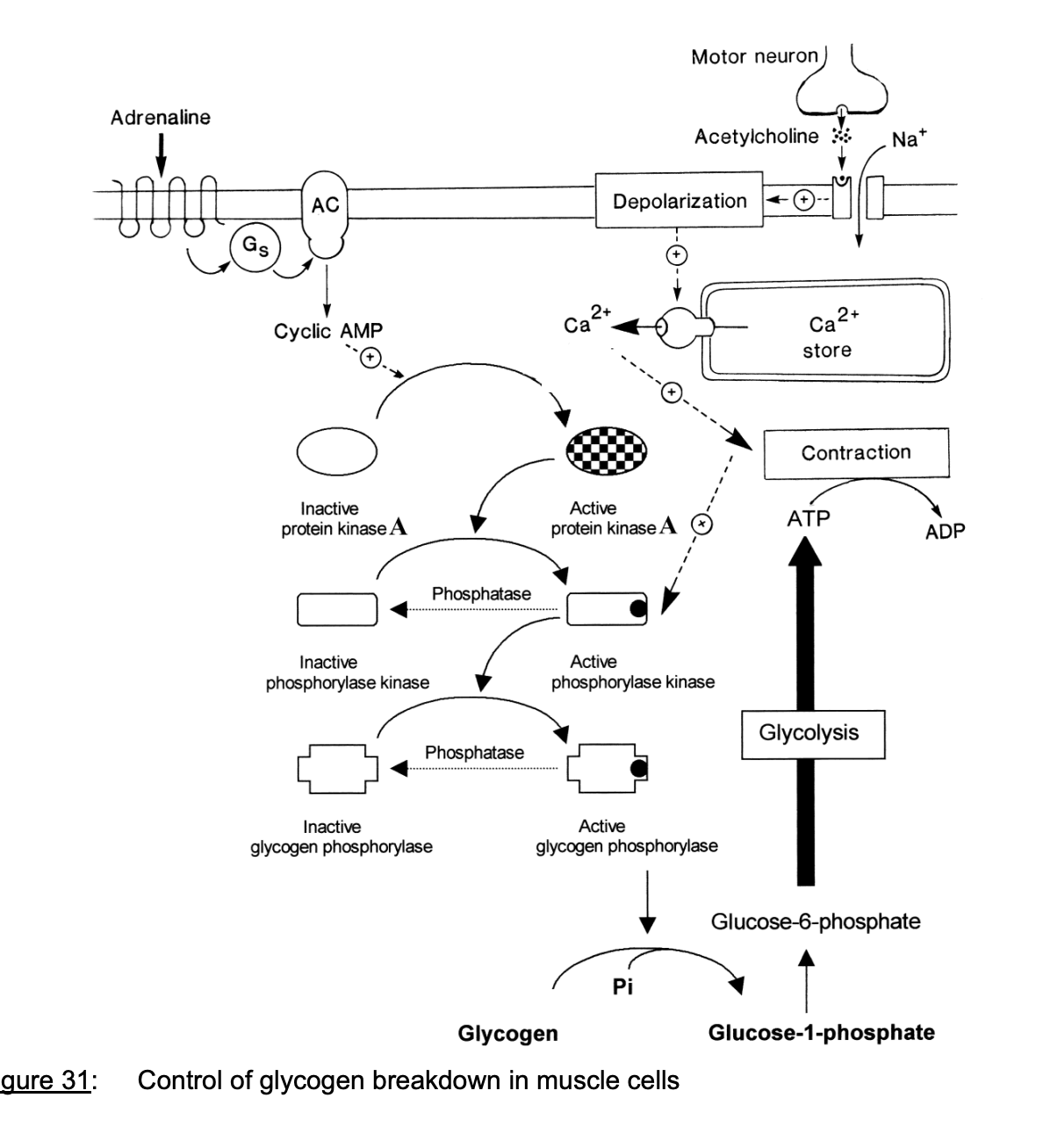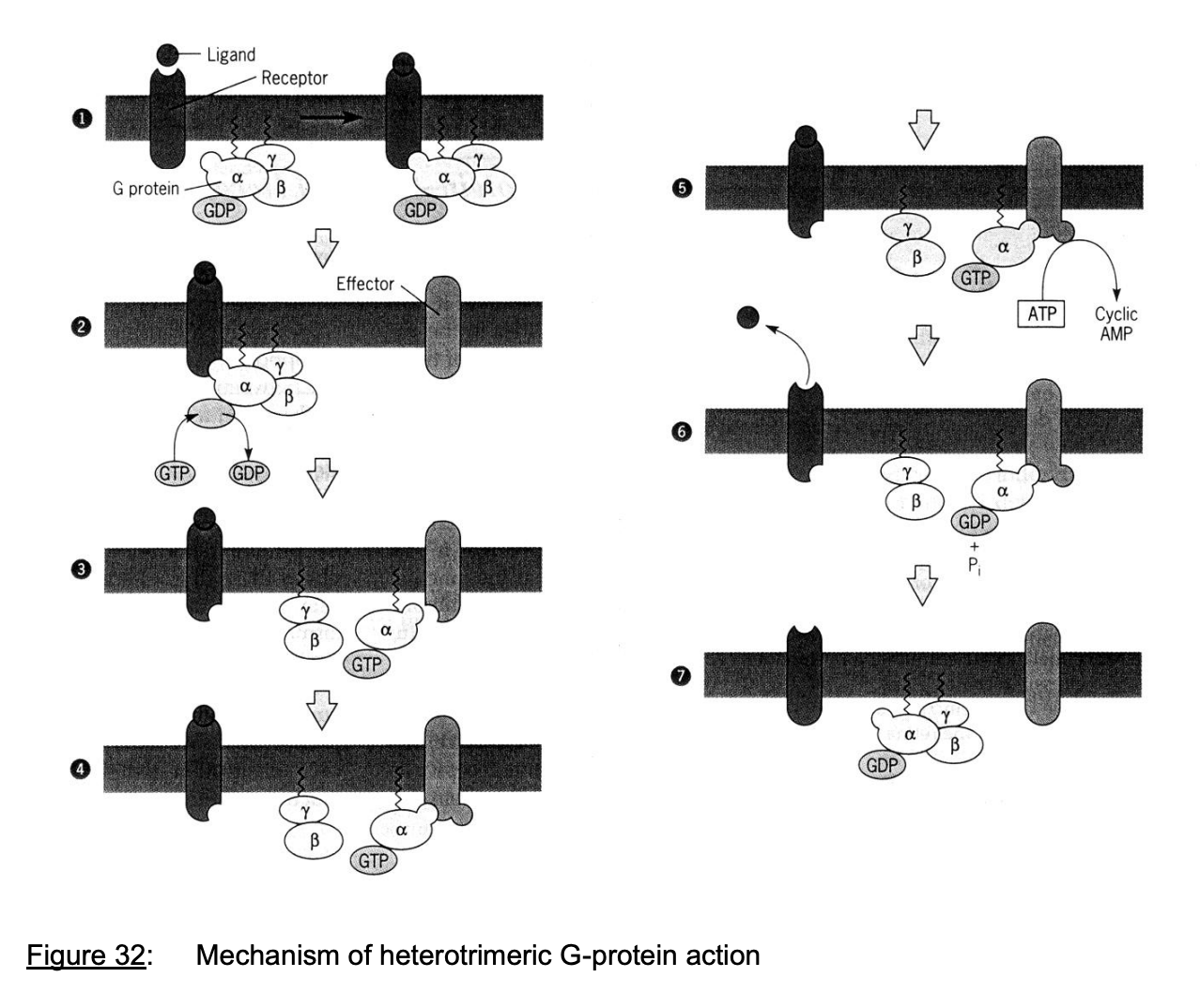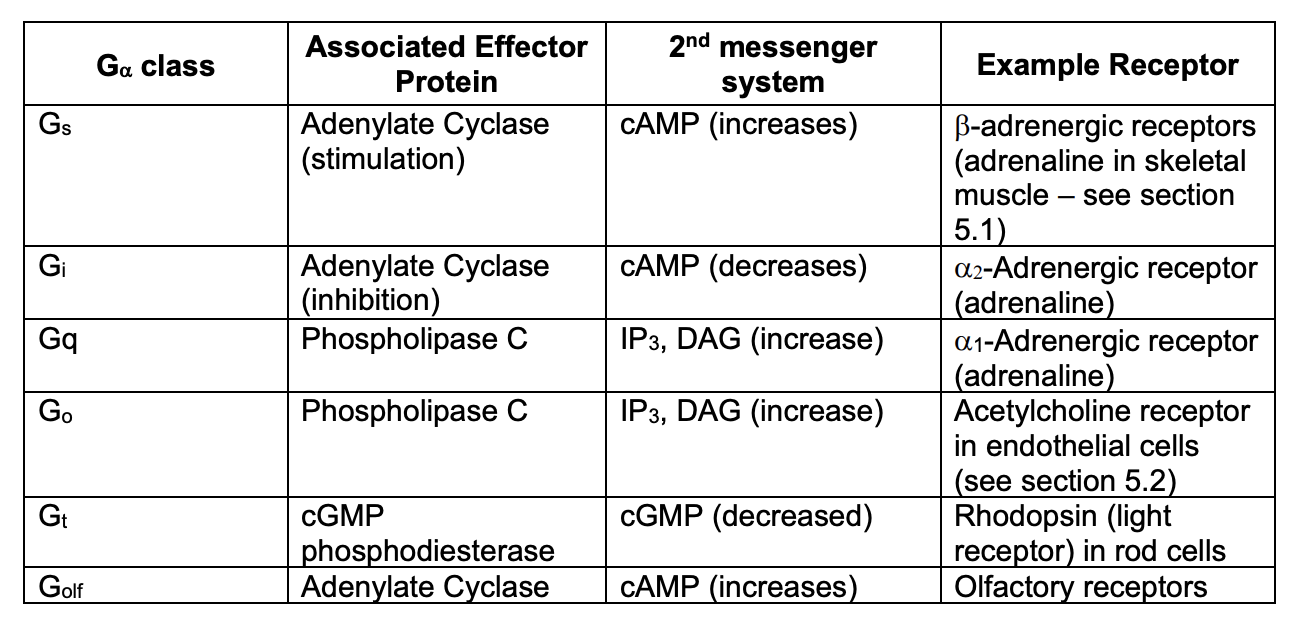Communication in Animals LECTURE 5
1/24
There's no tags or description
Looks like no tags are added yet.
Name | Mastery | Learn | Test | Matching | Spaced |
|---|
No study sessions yet.
25 Terms
Adrenlaine hormonal response
Stimulates glycogen hydrolysis in the muscle cells
Concentration of Adrenaline in the blood
Very small 10^-9M
→ similar to the binding constant for the hormones to the receptor
What is the binding constant for the hormones to the receptor
concentration of the hormones
at which 50% of the receptor binding sites are occupied
What does this concentration ensure?
cellular response to the presence of the hormones will be directly related to the hormone concentration
Sequence of events for stimlation of glycogen hydrolysis with adrenaline
Adrenaline binds to receptor
Actiavtes Gs
Activates adenylate cyclase→ synthesise cyclic AMP
cAMP→ activates Protein Kinase
Activates phosphorylase kinase→ into active form
NB Phosphorylase kinase is also activated by Ca2+
SECOND SIGNALLING PATHWAY
from the ACh stimulation for muscle contraction
Nicotinic ACh receptor, Na+ Ion channel
E.g we have Interconnecting pathways! CONVERGENCE
→ Level of metabolism is linked to the energy needs of the contractile machinery
Active phosphoylase kinase→ Activates glycogen phosphoylase byt phosphoylation
Resulting glucose-1-phosphate is fed into glycolytic pathway
Produces ATP
Heterotrimeric G proteins
E.g Gs and Gq
What is the strucutre of Gs
3 protein subunits
G alpha
G beta
G gamma
→ Heterotrimetic G protein

Mechanism of Heterotrimeric G- protein action
Unstimulated→ Exists as a trimer with GDP bound to Ga
unable to interact with or activate adenylaate cyclase
Hormones binds→
receptor conformation change
receptor associates with G protein complex
GDP replaced with GTP on Ga
Ga dissociate from Gb and Gy
Ga binds and activates adenylate cylcase
Adenylate cyclase synthesis cAMP

How is the Gs protein reset?
GTP cleaves to form GDP + Pi
by GTP hydrolysing activity of Ga subunit
Ga subunit detaches from adenylate cyclase
Re-associates with Gb and Gy
→ inactive complex again

Wide ranging role of G-protein
Many signal transpductions
visual excitation
olfaction
→ Associated with mantt inhertited disorders
Example of G-protein ingerited disorder
single amino acid substitution
forms G-protein isoform
interacts with luteinising hormone receptor
→ temperature sensitive response
Classes of Ga proteins
have different 2nd messenger
have different receptors
associated with different effector proteins
Adenylate cyclase
phopholpase C
cGMP phosphodiesterase

Characteristic of Adrenaline signalling pathway
Amplification
Lateral mobility of membrane
Down regulation
Amplification
Amplified 10^6 forld from 10^-9
Achieved by
Single receptors can activate multiple G-protein complexes
e.g like in cAMP for dictocelum slime mould etc
Adenylate cylcase acting catalytically to produce cAMP
Protein kinase and phosphorylase kinase acting cataltyically
Lateral mobility of membrane proeins
Essential for G protein function
System down regulation
Needed for when hormones concentration in blood stream falls. How?
Hydrolysis of GTP bound to Ga→ GDP
Hydrolysis of cAMP by phosphodiesteraseDephosphorylation of phosphorylase kinase and glycogen phosphorylase
by action of phosphatases
IMPORTANCE: glycogen breakdown only persist in the continued presence of
hormone
or
Ca2+ signals
How can down regulation be comprimised?
Caffeine
(cAMP elevation)
Bacterium Vibrio cholerae produces cholera toxin
(GTP bound elevation)
Caffeine→ what does it do
Acts as inhibitor of phosphodiesterase
Elevated cAMP levels
→ Alertness + muscle tremor
Cholera toxin→ in intestine
Protein toxin ADPribosylates the Ga subunit
Inhibits GTPase activise
GTP permanently bound
Adenylate cyclase permanently active
100fold increase in cyclic AMP concentration in
epithelial epithelial cell
Unpleast flow of Cl- and water into intestinal lumen
→ Dehydration→ death
Role of NO
regulation of blood pressure
→ maintained by state contraction of smooth muscle cells
surrounding blood vessels
How is NO formed
Arginine
NO synthetase actiavted by Ca2+
Argineine→ NO
NO synthesis pathway
Blood pressure too high→ stretch activated Ca2+ channels in endothelium
promote Ca2+ entry
Stimulates NO formation
also
ACh elevates internal Ca2+ levels
Ach at musculerinic receptors
Go G protein→ PLC→ IP3→ Ca2+→ NO synthase

NO action pathway
NO diffuse to the smooth muscle cells
Induces muscle relaxation via cGMP-dependent mechanism
Down regulation:
cGMP rapidly degraded by cGMP phosphodiesterase (PDE)
(target of the active ingredient in Viagra)

NB type of receptor used
ACh bind to muscarinic receptors
not
nicotinic ACh→ used for ACh- Gated Na+ channels
Self -assessment questions
1. What is convergence of signaling?
2. How does the Gs class of G proteins contribute to adrenaline signalling?
3. How does NO regulate blood pressure?